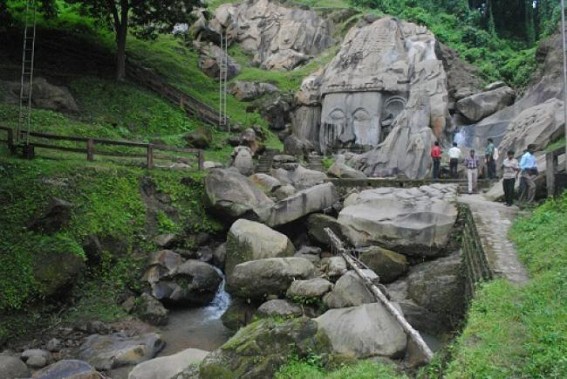Jayanta Bhattacharya, Sr. Journalist

PHOTO : TIWN
Aravind Adiga, a Men booker prize winner came to Tripura in the month of November in a short trip. He went back with a regret that he could not visit Unakoti. He sent me a mail – “I told many of my friends that anybody going to Tripura must see Unakotiâ€. Unakoti, its name meaning one less than a crore, dating back to the 8th or 9th century, is one of the biggest bas relief sculptures in India of gods and goddesses of Hindu mythology and scenes depicting the life of Lord Shiva.
In my teen age I stayed three years in Kailashahar, a small town and then district headquarters of North Tripura. The Unakoti site is just 10 KM from Kailashahar which could be approachable by vehicle. But,every year, during the Makar Shankranti I used to walk with a crowd of my friends through Devasthal tea estate to go there and buy small small things from a fair. Our bones were chilled when we took holy dip in Ram Kunda and Sita kunda.
Nestled on the Raghunandan hills, it is a 178 km drive from the state capital. According to Hindu mythology, when Lord Shiva was proceeding to Kashi along with a crore of gods and goddesses he made a night halt at Unakoti. Shiva instructed the gods and goddesses to wake up before dawn and proceed to Kashi.
In the morning when none except he got up, forcing him to set out for Kashi alone, Shiva cursed the gods and goddesses to turn up to be stones. Therefore 'Unakoti' acquired its name -- one less than one crore.
There is another myth associated with this enchanting place. It was the unfinished dream of a sculptor, who wished to make it a place of pilgrimage for a crore of deities. His dream remained incomplete, as one image was short, thus it came to be kjnown as Unakoti.
Panna Lal Roy, a scholar who studied the archeological site argued that it could be called the Ankorvat of the North-East.
"We can compare it with Ankor Vat, because we find an amalgamation of Hindu and Buddhist influences in the rockcut carvings though it is essentially a Hindu religious site with thousands of statues of Hindu god and goddesses", he told me.
The images are of two types, rock carved figures and stone images. Among the rock cut carvings, there is a 30 feet high image of Lord Shiva in grey stone carved into the vertical rock face.
A small, rock sprinkled stream flows besides the figure of Shiva.
The central Shiva known as 'Unokotiswara Kal Bhairava' is about 30 feet high including a 10 feet high embroidered head dress. On each side are two full size female figures - one of Goddess Durga standing astride a lion and another female figure.
There are also three 'Nandi' bulls half buried in the ground.
Just about fifty meters downstream, are three imposing images of Lord Ganesha. There is a gigantic four-armed seated Ganesha and on its side two standing figures of Sarabhuja Ganesha with three tusks and the Ashtabhuja Ganesh with four tusks.
The central Shiva and the gigantic Ganesha are masterpieces.
According to an assessment made by Archaeological Survey of India (ASI), some statues were still undiscovered in the jungles which needed to be preserved, while many were taken away by local people for worship at home.
We heard from reliable source that UNESCO is going to declare it as a world heritage site. Then only a greatest heritage site can be saved properly. But how long will we have to wait for this?
- Why Modi’s BJP swept key India regional elections
- TIWN’s landmark legal victory against BJP Govt’s Illegal attacks to shutdown fearless Media
- India to be world's third-largest economy by 2030 -S&P Global Ratings
- Tripura's Dark Era : Mafia style Brutal attacks on Journalists, fight for your Citizen rights !
- How to access tripurainfoway.com via HOLA from India



